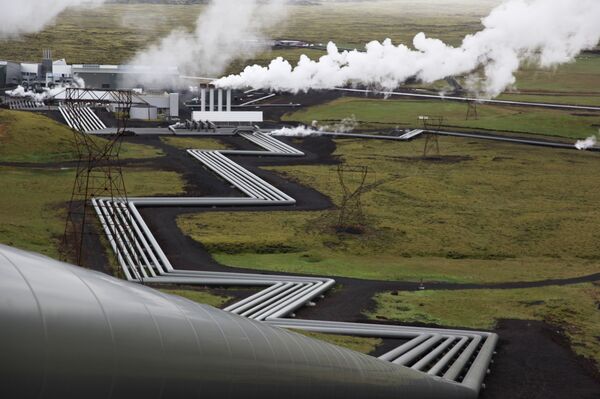A rig located at Reykjanes, in southwest Iceland, is drilling into hot rocks to tap into geothermal energy — heat emitted from the Earth, which is clean and sustainable. Geothermal energy can be "harvested" from shallow ground, hot water or rocks found a few miles beneath the Earth's surface and even deeper, in the extremely high temperatures of molten rock, known as magma.
The drilling into the geothermal well began on August 12, 2016 and plans to go five kilometers into the Earth's crust, where temperatures will reach between 400°C and 1,000°C. The scientists hope to find the sweet spot of temperatures and pressures, that will allow them to create, supercritical fluid, which is any substance at a temperature and pressure above its critical point.
This will allow them to potentially generate 50mW of power compared to just five megawatts from a typical well.
On January 25, drilling of the IDDP-2 well reached 4,659 meters, and temperatures at the bottom of the well measured at 427°C.

"This high-energy concentration of supercritical fluid will give us more output in terms of electricity than a conventional high-temperature fluid," Bjarni Palsson, manager of geothermal research and development at Landsvirkjun, which operates 17 power stations across Iceland, said in a recent interview.
Geothermal mudpool at Reykjanes Peninsula in Iceland. #visitreykjanes #geothermal #studytour #reykjanes #reykjanesgeopark pic.twitter.com/mKlN6B2VSG
— GeoCamp Iceland (@GeocampIceland) December 11, 2016
Dr. Jonathan Busby, team leader of renewables and energy security at the British Geological Survey (BGS), a company that researches geological innovations, said that this type of energy extraction is good for the environment. Dr. Busby also believes a key aim of Icelandic drilling is to develop an environmentally friendly way to extract the energy.
Magnus Helgason, managing editor of Iceland Magazine, said that environmentalists would want to see more advances in how geothermal energy is used.
Gunnuhver geothermal area in Reykjanes via @OZZOPhotography #midatlanticridge #geothermal #reykjanes #visitreykjanes #studytour pic.twitter.com/rFTuloFlAs
— GeoCamp Iceland (@GeocampIceland) January 17, 2017
"There is no opposition to this project. In fact, environmentalists would welcome any advances which make the generation of geothermal power more efficient."
"While geothermal power is green it comes at significant environmental costs. Geothermal areas, where geothermal power can be harnessed, are also among the most beautiful natural locations in Iceland. Drilling for geothermal power requires boreholes, roads, pipes carrying steam and other construction which alters the landscape, destroying untouched nature or beautiful formations. Reducing the number of boreholes needed by increasing the energy generated by each borehole should cut down on these effects," Mr. Helgason told Sputnik.
So what does the process of extraction involve?
"At the base of the well the temperatures and pressures will be high enough for water to be in a supercritical phase. Supercritical water can transport energy at an extremely high rate. As the supercritical water flows up the well, it decompresses and separates into two phases, water and steam. It is expected that the steam will be superheated and will then lead to the much greater power output when passed through the steam turbine," Dr. Jonathan Busby told Sputnik.
Geothermal energy is clean and sustainable. It is used to both generate electricity and as a means to cool and heat homes. #WednesdayWisdom pic.twitter.com/By1Q3ywNeV
— Columbian Park Zoo (@ColumbianPrkZoo) February 8, 2017
However, according to Dr. Busby, it should be noted that these wells are the first phase of a longer-term research and development project and it could be some years before commercial level power generation is underway from supercritical water. Mr. Helgason agrees that the technology is still in the early stages.
"The project is still in its infancy and it's still too soon to say with any certainty what the results will be, but it is certainly looking promising. Extracting energy directly from the earth‘s mantle provides us with a dramatic new option to generate green renewable energy and we desperately need this," Mr. Helgason told Sputnik.
"The IDDP is still in its experimental stage. It will take years before the project will actually generate energy. However, virtually all the power used to heat homes and businesses in Iceland is generated by geothermal power and 26 percent of all electricity used in Iceland is generated by geothermal power plants," he added.
#GeothermalEnergy in north #Iceland, great place to visit at #Namaskard near #Myvatn. #travel #climatechange @UNFCCC #holiday pic.twitter.com/21P4TzTkfb
— Iceland Photos (@dorisig) February 15, 2017
For Iceland, advancing this kind of project is extremely important, as the country has very much embraced renewable energy.
"Iceland is aiming to increase its output of renewable energy, despite the fact that almost 100 percent of its energy is already from renewable sources (hydropower and geothermal). There is a proposal for an electricity interconnector between Iceland and the UK and the electricity supplied to the UK could come from the new supercritical generation," Dr. Busby told Sputnik.
So could this type of energy be the newest kid on the block in terms of something that is sustainable, renewable and better for the environment?
"There are other developments in renewable energy, for example advances in solar power, but supercritical geothermal is exploiting a high energy density source. Which means large quantities of energy could be generated, from a fairly small setup of well heads," Dr. Busby explained.
#WhatWeDo: Promote Sustainable Development https://t.co/yNzpmSDgpW
— United Nations Photo (@UN_Photo) February 3, 2017
Geothermal energy heats greenhouses, is converted into electricity in NZ pic.twitter.com/QmkO9SYQ6m
"It can be done in other countries with volcanic conditions, for example, Italy, Japan, but not in the UK. But note that there are other ways such as engineered geothermal systems, that can generate geothermal power at the lower temperatures we have in the UK, but the power per well would be a lot less," he added.
This type of drilling does and has encountered problems however. For instance, the IDDP-1 project in 2009, failed due to problems experienced while drilling. The IDDP-2 is still in its infancy, so experts argue that unexpected problems will occur.




